Question
1. Read the case study, then answer the questions that follow. Case Study It starts off as a nice sunny day at Begonia Hills Childcare
1. Read the case study, then answer the questions that follow.
Case Study
It starts off as a nice sunny day at Begonia Hills Childcare Centre. Most of the children are outside enjoying their activities.
1a. What are three (3) potential hazards that you would have scanned the outdoor environment for prior to the children going outdoors?
2. If you wanted up-to-date information about sun safety, where would you find this?
3. Case study cont'd
Part way through the morning, the weather begins to change and a strong wind builds up. It starts to blow dust and leaves around and into the children's faces. A storm is brewing and it is coming fast.
The younger children are taken inside, while the older children help to pack up the equipment.
Suddenly rain is lashing at the windows. The children and educators who are caught in the rain outside now run into the room with their clothing and shoes soaked and dripping.
3a. Name one hazard that has been created and how you would rate the risk associated with it.
b. How would you manage this hazard?
Case study cont'd
The rain is still intense and the wind is driving it under a pergola onto the tiled pavement. Equipment under the pergola has also been knocked over.
4. What additional hazards have been created and who will you report them to?
5. Case study cont'd
As you are entering the room, you notice that water is dripping down through several light fittings and the lights are flickering. You report this immediately.
The director of the service sounds the alarm as an evacuation needs to take place. She asks you to call the fire brigade.
5a. If you are a student or a volunteer in your service, what is your role in this emergency?
b. What information do you need to give the fire department?
6. Case study cont'd
The rain and wind are easing as the emergency evacuation takes place.
There are a number of new staff in the service and they are unsure of their role. Some children are upset and others are not clear about what they are meant to be doing.
It takes some time to evacuate the building, partly due to the leaking light fittings blocking the usual exit path.
As you are moving outside the building, you see Anna, 5 years old, slip and graze her knee.
6a. Access an injury report from your service. List the information from the case study that needs to be included in the report.
.7 The next day, a meeting is held to reflect on the incidents. The following issues were identified:
- An evacuation has only been practised for a fire in the kitchen or the laundry.
- Some staff were unsure of what to do during the evacuation as there was a lack of signage.
What safety suggestions could you make at the meeting in relation to these points?
8. Case study cont'd
After the meeting, you notice that Sarah, a colleague, is crying. You talk to her and she tells you that she has had trouble sleeping since the incident. She feels anxious and worried that it may happen again. She has recurring headaches that she thinks are from the tension in her neck. She seeks your advice on what to do.
8a. List three (3) signs that may indicate that Sarah is feeling stressed or fatigued.
. b. Who should Sarah talk to within your service?
c) If she needs support from a WHS authority, who should she contact?
9. According to the document 'Guidance sheet 2: Dangerous Goods Classification System' on the State Government Victoria website, at: www.vic.gov.au. What would be an example of a Class 2 substance or article that might be on the premises?
Step by Step Solution
There are 3 Steps involved in it
Step: 1

Get Instant Access to Expert-Tailored Solutions
See step-by-step solutions with expert insights and AI powered tools for academic success
Step: 2

Step: 3

Ace Your Homework with AI
Get the answers you need in no time with our AI-driven, step-by-step assistance
Get Started


